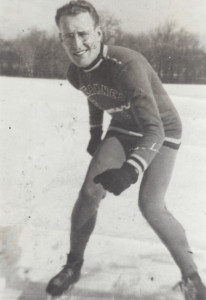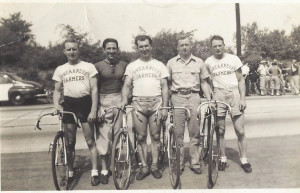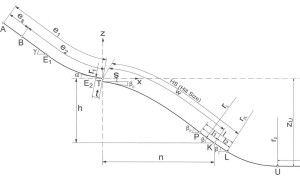Unfortunately, all Olympic fans sadly remember the death of Georgian luger Nodar Kumaritashvili, on the morning of the 2010 Vancouver opening ceremony. There were concerns about the track in Vancouver and its speed and difficulty. What is the sliding track like in Sochi, at the Sanki Sliding Centre? And how does it compare to Vancouver and other Olympics sliding tracks?
Below are the specifications for the Olympic sliding tracks at all the Olympics, although in some of the early years, some data is lacking. The three key factors are the length of the track, the gradient, or steepness of the hill, and especially the vertical drop.
Olympic Bobsledding Track Specifications
Two-Man
Year Curves Length Start Altitude Vertical Drop Gradient
1932 26 2,366 m 850 m 228 m 9.6%
1936 17 1,525 m 919 m 129 m 8.5%
1948 17 1,722 m — 130 m 7.5%
1952 13 1,508 m 429 m 124 m 8.2%
1956 16 1,700 m — 153 m 9.0%
1964 13 1,506 m 1,133 m 138 m 9.2%
1968 13 1,500 m 2,030 m 140 m 9.3%
1972 14 1,563 m 495 m 70 m 4.5%
1976 14 1,220 m 1,133 m 97 m 8.0%
1980 16 1,557 m 771 m 148 m 9.5%
1984 13 1,300 m 1,109 m 126 m 9.7%
1988 14 1,475 m 1,250 m 120 m 8.1%
1992 19 1,508 m 1,685 m 125 m 8.3%
1994 16 1,365 m 347 m 107 m 7.8%
1998 15 1,360 m 1,028 m 113 m 8.3%
2002 15 1,340 m 2,233 m 104 m 7.8%
2006 19 1,435 m 1,683 m 114 m 7.9%
2010 16 1,450 m 928 m 148 m 10.2%
2014 18 1,475 m 844 m 132 m 9.3%
Four-Man
Year Curves Length Start Altitude Vertical Drop Gradient
1924 19 1,370 m — 156 m 11.4%
1928 17 1,722 m — 130 m 7.5%
1932 26 2,366 m 850 m 228 m 9.6%
1936 17 1,525 m 919 m 129 m 8.5%
1948 17 1,722 m — 130 m 7.5%
1952 13 1,508 m 429 m 124 m 8.2%
1956 16 1,700 m — 153 m 9.0%
1964 13 1,506 m 1,133 m 138 m 9.2%
1968 13 1,500 m 2,030 m 140 m 9.3%
1972 14 1,563 m 495 m 70 m 4.5%
1976 14 1,220 m 1,133 m 97 m 8.0%
1980 16 1,557 m 771 m 148 m 9.5%
1984 13 1,300 m 1,109 m 126 m 9.7%
1988 14 1,475 m 1,250 m 120 m 8.1%
1992 19 1,508 m 1,685 m 125 m 8.3%
1994 16 1,365 m 347 m 107 m 7.8%
1998 15 1,360 m 1,028 m 113 m 8.3%
2002 15 1,340 m 2,233 m 104 m 7.8%
2006 19 1,435 m 1,683 m 114 m 7.9%
2010 16 1,450 m 928 m 148 m 10.2%
2014 18 1,475 m 844 m 132 m 9.3%
Two-Women
Year Curves Length Start Altitude Vertical Drop Gradient
2002 15 1,340 m 2,233 m 104 m 7.8%
2006 19 1,435 m 1,683 m 114 m 7.9%
2010 16 1,450 m 928 m 148 m 10.2%
2014 18 1,475 m 844 m 132 m 9.3%
Olympic Luge Track Specifications
Men’s Singles
Year Curves Length Start Altitude Vertical Drop Gradient
1964 18 1,058 m 1,133 m 113 m 10.7%
1968 14 1,000 m 1,110 m 110 m 11.0%
1972 14 1,023 m 443 m 101 m 9.9%
1976 14 1,220 m — 103 m 8.4%
1980 14 1,014 m 731 m 96 m 9.5%
1984 13 1,210 m 1,112 m 129 m 10.7%
1988 13 1,251 m 1,309 m 109 m 8.7%
1992 15 1,250 m 1,671 m 111 m 8.9%
1994 16 1,365 m 350 m 110 m 8.1%
1998 14 1,326 m 1,029 m 114 m 8.6%
2002 17 1,317 m — 106 m 8.0%
2006 19 1,435 m — 114 m 7.9%
2010 15 1,198 m 909 m 132 m 11.0%
2014 17 1,475 m 844 m 132 m 9.3%
Doubles
Year Curves Length Start Altitude Vertical Drop Gradient
1964 18 910 m 1,110 m 89 m 9.8%
1968 — — — — —
1972 11 763 m 420 m 78 m 10.2%
1976 10 870 m — 72 m 8.3%
1980 11 749 m 695 m 59 m 7.9%
1984 11 993 m 1,082 m 100 m 10.1%
1988 10 1,080 m 1,281 m 81 m 7.5%
1992 14 1,143 m 1,652 m 92 m 8.0%
1994 13 1,185 m 325 m 85 m 7.2%
1998 13 1,194 m 1,011 m 96 m 8.0%
2002 12 1,140 m — 77 m 6.8%
2006 17 1,233 m — 98 m 7.9%
2010 14 953 m 883 m 96 m 10.1%
2014 16 1,384 m 836 m 125 m 9.3%
Women’s Singles
Year Curves Length Start Altitude Vertical Drop Gradient
1964 18 910 m 1,110 m 89 m 9.8%
1968 — — — — —
1972 11 763 m 420 m 78 m 10.2%
1976 10 870 m — 72 m 8.3%
1980 11 749 m 695 m 59 m 7.9%
1984 11 993 m 1,082 m 100 m 10.1%
1988 10 1,080 m 1,281 m 81 m 7.5%
1992 14 1,143 m 1,652 m 92 m 8.0%
1994 13 1,185 m 325 m 85 m 7.2%
1998 13 1,194 m 1,011 m 96 m 8.0%
2002 12 1,140 m — 77 m 6.8%
2006 17 1,233 m — 98 m 7.9%
2010 14 953 m 883 m 96 m 10.1%
2014 16 1,384 m 836 m 125 m 9.3%
Olympic Skeleton Track Specifications
Men
Year Curves Length Start Altitude Vertical Drop Gradient
1928 15 1,231 m — 157 m 12.8%
1948 15 1,231 m — 157 m 12.8%
2002 15 1,335 m 2,233 m 104 m 7.8%
2006 19 1,435 m 1,683 m 114 m 7.9%
2010 15 1,450 m 928 m 148 m 10.2%
2014 18 1,475 m 844 m 132 m 9.3%
Women
Year Curves Length Start Altitude Vertical Drop Gradient
2002 15 1,335 m 2,233 m 104 m 7.8%
2006 19 1,435 m 1,683 m 114 m 7.9%
2010 15 1,450 m 928 m 148 m 10.2%
2014 18 1,475 m 844 m 132 m 9.3%
If everything else is equal, the vertical drop is what determines the speed. On a frictionless track, with no curves, the velocity one obtains would be as follows, if you remember your elementary physics:
V = √2gh
In the above, V = velocity, h = vertical drop (or height), and g = gravitational acceleration (=9.8 m/s). With no other forces, such as friction, the speed at the bottom can be determined by the equation relating potential and kinetic energy:
mgh = ½mV2
Which yields the above formula for the final velocity.
Now obviously there is friction, and there are curves. Modern sliding tracks really began in the 1960s with refrigerated tracks which are basically sheets of ice. Friction is pretty minimal now, but its still there. And some of the curves will slow down the sleds, although the highly banked tracks minimize that.
So looking at the above, we note that the Sanki track is a long one, at a maximum length of 1,475 metres. It is the longest ever luge or skeleton Olympic track, although several bob tracks have been longer.
The Vancouver track had a greater vertical drop and gradient than Sochi, however. In fact Vancouver had the steepest gradient and biggest vertical drop of any of the modern, iced Olympic tracks, although equalled by Lake Placid in 1980, which had the same vertical drop but less of a gradient. For bobsled and skeleton, the track in Vancouver dropped 148 metres at a gradient of about 10.2%, while Sochi drops 132 metres at a gradient of about 9.3%. The luge drop in Vancouver was less, but remember that that track was shortened, and started from lower down, after the fatal accident.
So if you are looking at the differences in the two tracks maximal potential speeds, they are as follows (using bobsled and skeleton drops):
Year Vertical Drop Max Speed
2010 148 m drop 194 km/hr (121 mph)
2014 132 m drop 183 km/hr (114 mph)
Now obviously the sleds never get that fast, as this assumes a frictionless surface and no curves. Maximum speeds hover about 90 mph, or 145 km/hr in skeleton and luge, and can get to 95 mph, or 150 km/hr in bobsled. But what this does show is that the Sanki Sliding Centre track is not as fast as Vancouver’s was, by a factor of about 6% potential maximum speed.


